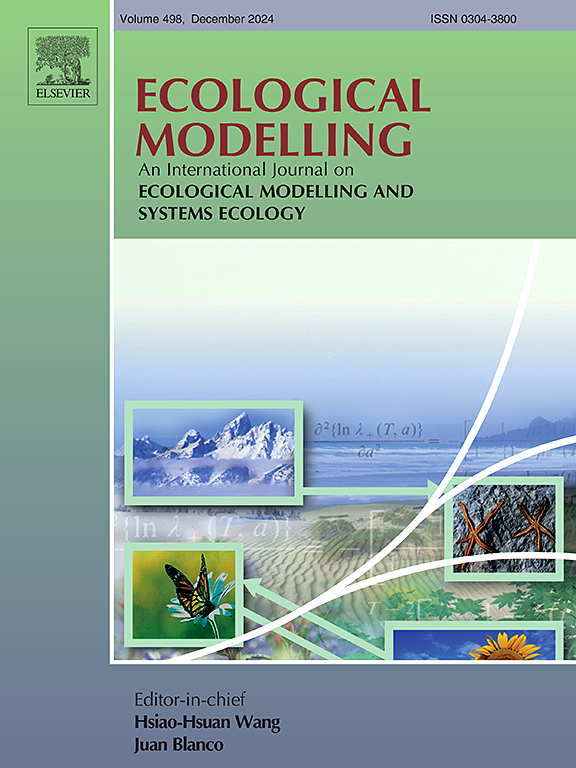拉马沼虾与罗氏沼虾清洗共生防治孟加拉泥鳅效果的数学验证
IF 3.2
3区 环境科学与生态学
Q2 ECOLOGY
引用次数: 0
摘要
争论病是由甲壳纲(鳃目)外寄生虫Argulus spp.引起的,对全球水产养殖业造成了重大的经济损失。最近,人们提出了一种潜在的生物防治策略,该策略涉及三种不同生物的同居:客用鱼Labeo rohita (F), lamarrei Macrobrachium (P)和寄生虫Argulus bengalensis (a)。然而,这种关联的有效性仅在微观实验中得到证实;没有进行现场应用。因此,为了填补这一空白,目前的解释已经针对这三种关联的数学验证进行了指导,以成功地大规模应用。为此,提出了一个包含三个状态变量F、P和A的概念模型。建立数学模型的参数值是通过微观实验、野外观测和标定得到的。在微环境下,维持顾客、清洁者和寄生虫的比例为1:5:100,以获得鱼与泥鳅的相互作用系数(α)和对虾的最大捕食率(γ)。然而,维持1:1:100的比例也创造了一个“理想”条件,以获得捕食的半饱和常数(h)。鱼的内在生长率(r)和养殖系统的承载能力(K)的值根据特定的混养系统确定,该特定比例为1:2:50。采用Holling III型方程求解该数学模型方程。结果表明,对虾的捕食率与泥鳅种群数量呈负相关,直接影响对虾种群数量。因此,在不影响生态系统平衡的情况下,拉马氏微囊藻可作为复合鱼类养殖中的一种补充物种来调节养殖系统中的泥鳅负荷。此外,本研究是一项考虑三种相互作用物种的双重作用进行模型形成和分析的新颖工作。因此,目前的研究在水产养殖和生态学领域都具有重要意义。本文章由计算机程序翻译,如有差异,请以英文原文为准。
Mathematical validation of cleaning symbiosis between Macrobrachium lamarrei and Labeo rohita as an effective bio-control method against Argulus bengalensis
Argulosis, caused by the crustacean (Order- Branchiura) ectoparasite Argulus spp., poses a significant economic loss in global aquaculture. Recently, a potential bio-control strategy against argulosis was proposed, which involved three taxonomically separate organisms in cohabitation: the client fish Labeo rohita (F), the cleaner prawn Macrobrachium lamarrei (P), and the parasite Argulus bengalensis (A). However, the effectiveness of the association was only proven in a microcosm experiment; no field application was performed. Therefore, to fill this gap, the present interpretation has been directed towards a mathematical validation of this three-species association for its successful large-scale field application. A conceptual model is proposed with the three state variables F, P and A for this purpose. The parametric values, used to formulate the mathematical model, were obtained from the microcosm experiment, field observation and calibration. The experiment was conducted in microcosm maintaining the client, cleaner and parasite ratio as 1:5:100 for acquiring the values of the coefficient of interaction () between the fish and Argulus and the maximum predation rate () of prawn. However, an ‘ideal’ condition was also created by maintaining this ratio as 1:1:100 to obtain half saturation constant of predation (). The values of intrinsic growth rate (r) of fish and carrying capacity (K) of the aquaculture system were determined according to a particular polyculture system where this specific ratio was 1:2:50. The Holling type III equation was used to solve this mathematical model equation. The result demonstrates that the predation rate of the prawn species inversely influences the Argulus population and directly influences the prawn population. Therefore, M. lamarrei can be used as an additional species in composite fish culture to regulate Argulus load in aquaculture systems without compromising the balance of an ecosystem. Moreover, this study is a novel work that considers dual role of the three interacting species for model formation and analysis. So, the current study is important in both the sectors of aquaculture and ecology.
求助全文
通过发布文献求助,成功后即可免费获取论文全文。
去求助
来源期刊

Ecological Modelling
环境科学-生态学
CiteScore
5.60
自引率
6.50%
发文量
259
审稿时长
69 days
期刊介绍:
The journal is concerned with the use of mathematical models and systems analysis for the description of ecological processes and for the sustainable management of resources. Human activity and well-being are dependent on and integrated with the functioning of ecosystems and the services they provide. We aim to understand these basic ecosystem functions using mathematical and conceptual modelling, systems analysis, thermodynamics, computer simulations, and ecological theory. This leads to a preference for process-based models embedded in theory with explicit causative agents as opposed to strictly statistical or correlative descriptions. These modelling methods can be applied to a wide spectrum of issues ranging from basic ecology to human ecology to socio-ecological systems. The journal welcomes research articles, short communications, review articles, letters to the editor, book reviews, and other communications. The journal also supports the activities of the [International Society of Ecological Modelling (ISEM)](http://www.isemna.org/).
 求助内容:
求助内容: 应助结果提醒方式:
应助结果提醒方式:


